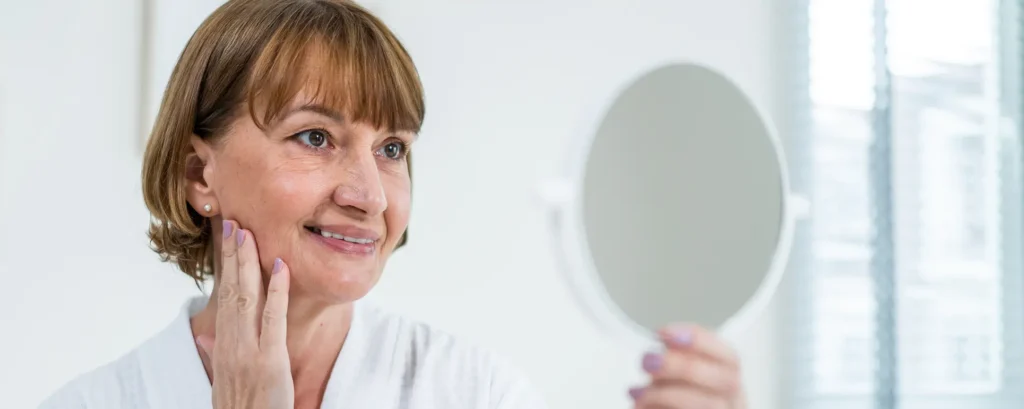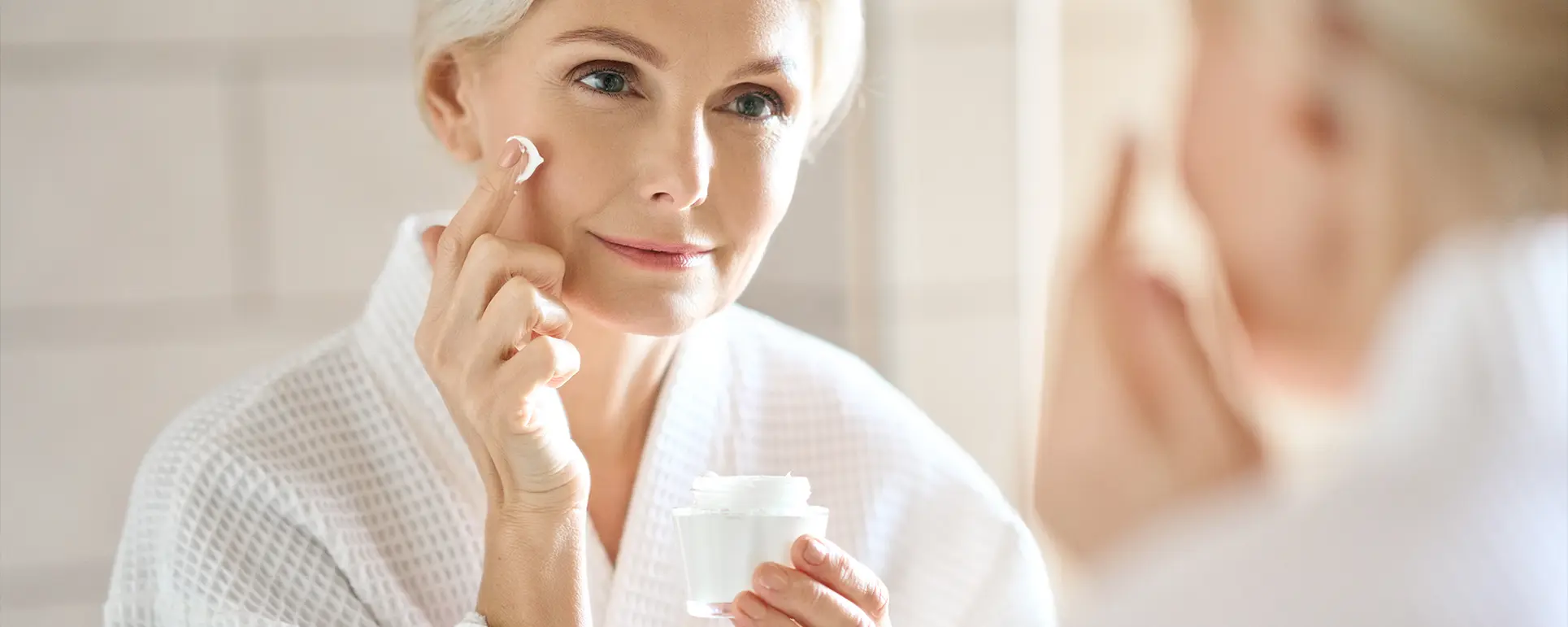You look in the mirror one morning and notice something that catches your eye dark patches scattered across your face, hands, or arms. Maybe you didn’t see them yesterday, or perhaps you just didn’t pay attention. Suddenly, it feels like these spots have appeared out of nowhere. You might be asking yourself, “Why am I suddenly getting so many age spots?” and wondering if something is wrong with your skin.
The truth is, age spots don’t usually appear overnight. They develop gradually over months or even years, often as a result of long-term sun exposure, natural changes in your skin, or even shifts in your hormones. But because they can multiply or darken over time, it can feel like they all showed up at once. That sudden “appearance” is really just your skin catching up to the changes that have been happening quietly beneath the surface.
In this guide, I’ll walk you through the most common reasons why you might notice a sudden increase in age spots, what you can do to manage them, and the signs that suggest it’s time to seek professional advice. By the end, you’ll have a clearer understanding of what’s happening with your skin and how to care for it so you feel confident again.
It’s also important to remember that age spots are a normal part of getting older, and most people experience them at some point. While they’re usually harmless, understanding why they appear and how to prevent them from worsening can help you take control of your skin’s health. After all, a little knowledge goes a long way in keeping your skin looking its best and helping you feel comfortable in your own skin.
What Are Age Spots?

Age spots, which you might also hear called liver spots or solar lentigines, are flat, brown, or black marks that tend to show up on areas of skin you expose most to the sun. You’ll commonly notice them on your face, the backs of your hands, shoulders, arms, and upper back basically, anywhere the sun hits regularly over the years.
These spots happen because of an overproduction of melanin, the pigment that gives your skin its colour. When your skin is exposed to UV rays, it produces extra melanin as a natural defence mechanism. Over time, those extra pigment cells can clump together, and that’s when you start to see those dark patches appear.
While age spots aren’t harmful and don’t usually signal any serious health problem, they can be frustrating if you’re concerned about your skin’s appearance. You might feel like your skin looks older, uneven, or blotchy, and that can be irritating when all you want is a smooth, clear complexion. The good news is that there are ways to manage them, prevent new ones from forming, and even fade the ones you already have, which we’ll explore later in this guide.
Why Do Age Spots Suddenly Appear?
It can feel like age spots appear out of nowhere, but there are a few key reasons why you may notice more all at once.
1. Sun Exposure Over Time
The number one cause of age spots is sun exposure. UV rays penetrate your skin and speed up melanin production, which can lead to those stubborn dark patches over time. Even if you’ve been careful recently with sunscreen or protective clothing, the sun damage from years ago can catch up with you now, making spots appear seemingly out of nowhere. Your skin has a long “memory,” and the effects of past sun exposure often show up later in life.
Spots often appear more suddenly after holidays in sunny climates or after periods when you’ve spent extra time outdoors without enough protection. That’s why areas like your face, chest, and hands are often the first to show them, since they get the most direct sunlight.
2. Ageing Skin
As you age, your skin becomes less efficient at repairing itself. Tiny damages from the environment, sun, or everyday wear and tear take longer to heal, which can make dark spots more likely to form. Pigment cells, or melanocytes, also become more irregular over time.
That’s why people over 40 often start seeing them more frequently your skin’s natural resilience has simply slowed down. Even if you’ve taken excellent care of your skin in the past, ageing is a normal process that affects everyone differently. You might find that spots appear more quickly than you expected, or that areas that never had them before suddenly start showing patches.
3. Hormonal Changes
Hormones play a huge role in skin health. Pregnancy, menopause, or even starting or stopping hormone-related medication can trigger pigmentation changes.
If you’ve recently experienced hormonal fluctuations, you might see age spots appearing more quickly than before. These changes can overlap with other pigmentation issues such as melasma, which sometimes makes diagnosis tricky.
4. Genetics
Your family history matters. If your parents or grandparents developed age spots early or in large numbers, you may be more prone to them.
Genes influence how your skin responds to UV damage, how much melanin you produce, and how quickly your skin repairs itself.
5. Skin Trauma and Healing
Sometimes, age spots can appear in areas where your skin has experienced trauma. Cuts, burns, acne scars, or even minor injuries can leave behind pigmentation as they heal. Your skin may overproduce melanin in response to the damage, which can result in dark spots that seem to pop up unexpectedly.
If you’ve recently had skin irritation or an injury, you might suddenly notice new dark patches in those areas. Even things like frequent friction from clothing, shaving, or scratching can trigger pigment changes over time. This is your skin’s way of protecting itself, but it can feel frustrating when these spots appear seemingly out of nowhere.
6. Medications and Photosensitivity
Certain medications make your skin more sensitive to sunlight. These include antibiotics, anti-inflammatories, and some heart or blood pressure drugs.
If you’ve recently started new medication, your skin may be reacting more strongly to UV exposure, leading to age spots developing faster.
7. Lifestyle Factors
Other everyday habits can also influence how quickly age spots appear. For example:
- Smoking, which accelerates skin ageing.
- Poor diet, lacking in antioxidants that protect your skin.
- High stress, which affects your skin’s ability to repair itself.
All of these can make your skin more vulnerable to sun damage and pigmentation changes.
Are Age Spots Dangerous?

The good news is that most age spots are harmless. They don’t develop into skin cancer and they don’t cause physical discomfort.
However, any new or changing dark spot should be checked by a dermatologist. Melanoma a type of skin cancer can sometimes look similar to an age spot. Warning signs include:
- Irregular borders.
- Multiple colours in one spot.
- Rapid growth or changes in appearance.
If you’re unsure, always seek professional advice rather than guessing.
How to Tell the Difference Between Age Spots and Other Pigmentation
It’s easy to confuse age spots with other skin issues like freckles, melasma, or post-inflammatory hyperpigmentation. Here are some quick distinctions:
- Freckles: Usually lighter and fade in winter.
- Melasma: Larger, patchy areas often triggered by hormones.
- Post-inflammatory pigmentation: Appears after acne, burns, or cuts.
Age spots are usually darker, more defined, and stay visible year-round.
Prevention: How to Stop New Age Spots Forming
If you’ve suddenly noticed a surge of age spots, prevention becomes even more important. Here are the key steps:
- Daily SPF: The single most effective way to prevent more spots. Use broad-spectrum SPF 30 or higher every day.
- Protective clothing: Hats, sunglasses, and long sleeves help reduce UV exposure.
- Avoid peak sun hours: Try to stay out of direct sunlight between 10am and 4pm.
- Antioxidant skincare: Products with vitamin C, niacinamide, or green tea extract help protect against free radical damage.
Think of prevention as protecting your future skin, even if existing spots are already visible.
Treatment Options for Age Spots
The sudden appearance of age spots doesn’t mean you’re stuck with them. There are effective treatments to fade or remove them.
Topical Creams
Dermatologists often recommend creams with ingredients like:
- Hydroquinone.
- Retinoids (like tretinoin).
- Vitamin C.
- Kojic acid.
These work by slowing melanin production and encouraging skin cell turnover. Results take time but can be noticeable with consistent use.
Chemical Peels
Chemical peels use specially formulated acids to gently exfoliate the outer layer of your skin, encouraging fresh, new skin to replace it. This process helps to fade lighter age spots, smooth rough patches, and improve your overall skin tone. You might notice gradual improvement over a few sessions, and the results can be especially satisfying when combined with good sun protection and a proper skincare routine.
While chemical peels are effective for many people, it’s important to have them performed by a trained professional to minimise irritation and ensure the right strength for your skin type. After a peel, your skin may be temporarily red or sensitive, but with proper aftercare, it can look brighter, more even, and rejuvenated. This treatment is a popular choice if you want noticeable results without more invasive procedures.
Laser Therapy
Laser treatments target pigment directly, breaking down melanin clusters so your body can absorb them. This method is often quicker and more precise than creams or peels.
If you’re considering age spots removal, laser therapy is one of the most effective professional options available.
Cryotherapy
This involves freezing age spots with liquid nitrogen, causing them to flake off. It’s often used for individual spots but isn’t suitable for larger areas.
Microdermabrasion
Microdermabrasion is a gentler, more superficial treatment that works by buffing away the outer layer of your skin. This process helps to reduce the appearance of lighter age spots, smooth rough patches, and give your skin a fresher, more even look. You might notice gradual improvements over a series of sessions, and many people find it a convenient option because it usually involves little to no downtime.
It’s a popular choice if you’re looking for subtle yet noticeable results without the intensity of stronger treatments like chemical peels or laser therapy.
When to See a Dermatologist
If your age spots have suddenly increased, it’s worth seeing a dermatologist. They can confirm whether the spots are harmless and discuss treatment options tailored to your skin type.
Professional advice is especially important if:
- You’re under 40 and notice many new spots.
- Spots look irregular, raised, or keep changing.
- Home treatments haven’t worked.
The Emotional Side of Age Spots
It’s worth mentioning that age spots don’t just affect your skin they can affect your confidence. Suddenly seeing them can make you feel older or less comfortable in your own skin.
Talking to a dermatologist and exploring treatment can help you regain confidence, but so can reframing how you see them. For many people, they’re simply a natural sign of life and experience.
FAQs:
1. Can age spots appear suddenly?
It may feel like age spots appear overnight, but they actually develop gradually. Years of sun exposure, hormonal changes, or natural ageing can cause pigment to accumulate over time. What seems sudden is usually your skin reaching a tipping point where the spots become visible, rather than them actually forming in a single day.
2. Are age spots dangerous?
Most age spots are harmless and don’t turn into cancer. However, any new, rapidly changing, or irregularly shaped spot should be checked by a dermatologist. Conditions like melanoma can sometimes resemble age spots, so it’s better to get a professional assessment if you notice anything unusual.
3. Why do age spots appear more on certain areas?
Age spots are most common on areas exposed to sunlight, like the face, hands, shoulders, and arms. These spots form where UV rays repeatedly stimulate melanin production over the years. Areas usually covered by clothing tend to have fewer or no spots.
4. Can younger people get age spots?
While age spots are more common after 40, younger people can develop them too, especially with significant sun exposure or genetic predisposition. Frequent tanning, outdoor sports, or even using tanning beds can increase the risk in younger adults.
5. Do hormones affect age spots?
Yes. Hormonal changes, such as those during pregnancy, menopause, or when taking or stopping hormone-related medications, can trigger pigmentation changes. These shifts can make existing spots darker or cause new ones to appear more quickly.
6. Can medications make age spots worse?
Certain medications increase photosensitivity, making your skin more prone to sun damage. Antibiotics, anti-inflammatories, and some heart or blood pressure medications are examples. If you’ve recently started a new medication, you might notice your age spots darkening or appearing faster.
7. How can I prevent new age spots?
The most effective prevention is consistent sun protection. Use broad-spectrum SPF 30 or higher daily, wear protective clothing, and avoid peak sun hours. Antioxidant-rich skincare with vitamin C or niacinamide can also help protect against free radical damage and slow the formation of new spots.
8. What treatments are available for age spots?
There are several options depending on the type and severity of spots. Topical creams, chemical peels, laser therapy, cryotherapy, and microdermabrasion are all effective ways to reduce or remove age spots. A dermatologist can recommend the best treatment plan for your skin.
9. How long does it take to see results from treatments?
Results vary depending on the method used. Topical creams may take several weeks to months, while chemical peels or laser treatments can show visible improvement after a few sessions. Consistent sun protection and proper skincare after treatment are key to maintaining results.
10. Should I see a dermatologist for age spots?
If you notice a sudden increase in spots, irregular shapes, rapid changes, or if home treatments haven’t worked, it’s a good idea to consult a dermatologist. They can confirm whether your spots are harmless and guide you on the safest and most effective treatment options.
Final Thought: Taking Control of Your Age Spots
Noticing age spots on your skin can be surprising, especially when it feels like they appeared all at once. While they’re usually harmless, it’s natural to want a smoother, more even complexion. The good news is that there are several effective ways to manage and reduce age spots, from professional treatments like chemical peels, microdermabrasion, and laser therapy, to diligent sun protection and targeted skincare at home.
If you’re considering professional help, you can get in touch with the London Dermatology Centre for expert Age Spots Removal advice. Their team of experienced dermatologists can assess your skin and recommend the most suitable treatment for your individual needs, ensuring safe and effective results. Taking that step can help you feel confident in your skin again and prevent new spots from forming in the future.
References:
1. Mardani, G., et al. (2025). ‘Treatment of Solar Lentigines: A Systematic Review’. Journal of Cosmetic Dermatology, 24(1), pp. 1–10. Available at: https://onlinelibrary.wiley.com/doi/pdf/10.1111/jocd.70133
2. Choi, W., et al. (2017). ‘Molecular and histological characterization of age spots’. Journal of Dermatological Science, 86(2), pp. 111–118. Available at: https://pmc.ncbi.nlm.nih.gov/articles/PMC5342934/
3. Mayo Clinic. (2023). ‘Age spots (liver spots) – Symptoms & causes’. Available at: https://www.mayoclinic.org/diseases-conditions/age-spots/symptoms-causes/syc-20355859
4. Harvard Health Publishing. (2023). ‘Age spots (liver spots) – Diagnosis & treatment’. Available at: https://www.health.harvard.edu/a_to_z/age-spots-solar-lentigo-liver-spots-a-to-z
5. Cleveland Clinic. (2023). ‘Liver Spots: Causes, Symptoms and Treatment’. Available at: https://my.clevelandclinic.org/health/diseases/21723-liver-spots
